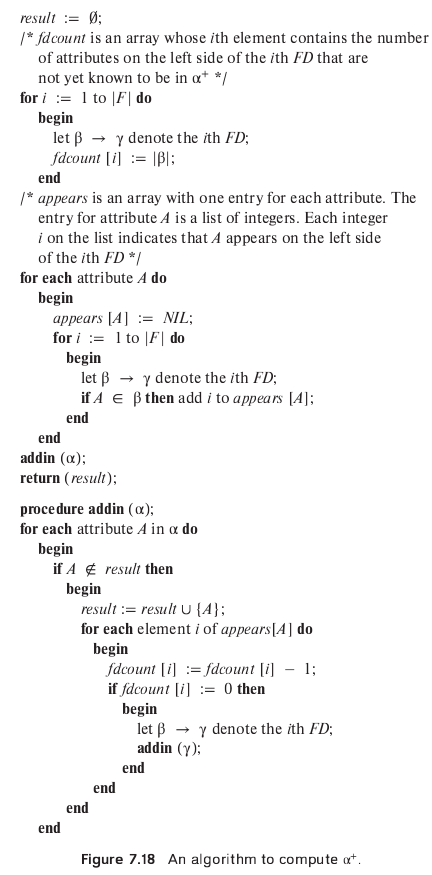7.8
Consider the algorithm in Figure 7.18 to compute \(\alpha^+\). Show that this algorithm is more efficient than the one presented in Figure 7.8 (Section 7.4.2) and that it computes \(\alpha^+\) correctly.

The algorithm is correct because:
If \(A\) is added to result then there is a proof that \(\alpha \rightarrow A\). To see this, observe that \(\alpha \rightarrow \alpha\) trivially, so \(\alpha\) is correctly part of result. If \(A \not\in \alpha\) is added to result, there must be some FD \(\beta \rightarrow \gamma\) such that \(A \in \gamma\) and \(\beta\) is already a subset of result. (Otherwise fdcount would be nonzero and the if condition would be false.) A full proof can be given by induction on the depth of recursion for an execution of addin, but such a proof can be expected only from students with a good mathematical background.
If \(A \in \alpha^+\), then \(A\) is eventually added to result. We prove this by induction on the length of the proof of \(\alpha \rightarrow A\) using Armstrong’s axioms. First observe that if procedure addin is called with some argument \(\beta\), all the attributes in \(\beta\) will be added to result. Also if a particular FD’s fdcount becomes 0, all the attributes in its tail will definitely be added to result. The base case of the proof, \(A \in \alpha \Rightarrow A \in \alpha^+\), is obviously true because the first call to addin has the argument \(\alpha\). The inductive hypothesis is that if \(\alpha \rightarrow A\) can be proved in n steps or less, then \(A \in\) result. If there is a proof in \(n + 1\) steps that \(\alpha \rightarrow A\), then the last step was an application of either reflexivity, augmentation, or transitivity on a fact \(\alpha \rightarrow \beta\) provided in \(n\) or fewer steps. If reflexivity or augmentation was used in the \((n+1)^{st}\) step, \(A\) must have been in result by the end of the \(n^{th}\) step itself. Otherwise, by the inductive hypothesis, \(\beta \subseteq\) result. Therefore, the dependency used in proving \(\beta \rightarrow \gamma\), \(A \in \gamma\), will have fdcount set to 0 by the end of the \(n^{th}\) step. Hence \(A\) will be added to result.
To see that this algorithm is more efficient than the one presented in the chapter, note that we scan each FD once in the main program. The resulting array appears has size proportional to the size of the given FDs. The recursive calls to addin result in processing linear in the size of appears. Hence the algorithm has time complexity which is linear in the size of the given FDs. On the other hand, the algorithm given in the text has quadratic time complexity, as it may perform the loop as many times as the number of FDs, in each loop scanning all of them once.